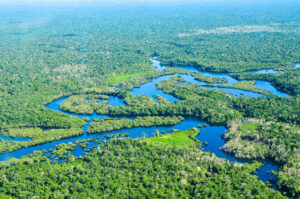Global heating, regional climate change and deforestation may work in synergy to accelerate forest loss, pushing the Amazon rainforest towards a dramatic dieback and partial or even total collapse this century.

A study published today in the journal Nature, shows how their combined effects could pass a ‘tipping point’ – when the rainforest becomes so fragile that a tiny disturbance could trigger an abrupt and irreversible shift to a grassy savannah or a degraded state in a decade or two, potentially also destabilizing the global climate system.
The Amazon rainforest is one of a handful of tipping points which concern scientists because they represent thresholds beyond which the global climate system could shift into a new state, affecting patterns of rainfall and more over large areas.
The stakes are high because the Amazon rainforest, the subject of the recent Amazônia exhibition in the Science Museum and Science and Industry Museum, is home to 10% of Earth’s biodiversity, stores carbon equal to 15 to 20 years of Earth’s emissions and is responsible for a net cooling effect that helps to stabilize the planet’s climate.
Although rainforests such as the Amazon are seen as ‘carbon sinks’, that is they absorb the carbon dioxide responsible for global heating, recent studies suggest that the south-eastern Amazon may already be releasing carbon, probably as a result of changes in land use, such as deforestation.
But if it passes a tipping point the Amazon, a global sink for carbon, could release massive amounts of carbon to accelerate climate change.
The Federal University of Santa Catarina in Brazil led today’s study, with team members from Brazil, Europe, and USA to help develop measures to boost the resilience of the Amazon rainforest, dubbed the ‘lungs of the Earth’.
‘Compounding disturbances are increasingly common within the core of the Amazon,’ commented the first author of the study, Bernado Flores of the Federal University. ‘If these disturbances act in in synergy, we may observe unexpected ecosystem transitions in areas previously considered resilient, such as the moist forests of the western and central Amazon.’
Between 10% and 47% of forests may be exposed to climate and land use stresses that could push the Amazon past a tipping point as soon as 2050, according to the paper.
With its roughly 390 billion trees, the Amazon creates its own weather: it is a self-sustaining ‘rain machine’ in which ‘rivers in the sky’ circulate moisture in the region, even influencing other parts of the world, such as Asia and Antarctica.
Every day, trees in the forest pump enormous amounts of water – up to five hundred litres from an individual tree – from the soil into the atmosphere, and also release volatile organic compounds that help to seed clouds and rainfall. Because winds flow from east to west, carrying clouds and moisture with them, they create rainfall along the way to make the forests more resilient.
The result is what scientists call a ‘non-linear’ effect, caused by a ‘positive feedback’ mechanism in which forests boost rainfall and in return the rainfall increases forest resilience. This reinforcing feedback is the secret of why the Amazon Forest has persisted, despite large climatic fluctuations in the past, and being located on latitudes which are more conducive to scrubby savannah.
But in recent decades, this crucible of biodiversity has faced unprecedented stress from climatic and changes in land use, from rising temperatures to extreme drought, deforestation and fires.
The feedback mechanism that makes the forest resilient is weakening while new feedback mechanisms can come into play that could accelerate forest loss, as carbon is released to amplify climate change.
The study authors used records of ancient climates stretching back around sixty-five million years, computer models of the climate, along with data gathered since the 1980s, such as satellite observations of forest fire, tree cover and deforestation.
They focused on disturbed forests in various parts of the Amazon to reveal three main ways that ecosystems can change in coming years: ‘In some cases, the forest may recover, but remains trapped in a degraded state, dominated by opportunistic plants, such as lianas or bamboos,’ said Flores. ‘In other cases, the forest does not recover anymore, and persists trapped in an open-canopy, flammable state.’
The expansion of open, flammable ecosystems at the heart of the Amazon Forest is particularly concerning because they can spread fires to adjacent forest. ‘Road construction through central and western parts of the Amazon are contributing to spreading more fires and illegal activities, increasing the risk of transitions at the resilient core of the system,’ added Flores.
The study also considers the roles of biodiversity and Indigenous peoples, showing how they can make the ecosystem more adaptable and resilient. In recent years, evidence has emerged of 2,500 year old cities in the region, for example, showing how populations of people can live sustainably with the rainforest. ‘Today, land-use changes in region are destroying both biodiversity and the ancient ecological knowledge of Amazonian peoples that sustained heathy and resource-rich forests for millennia,’ said Carolina Levis, coauthor.
To avoid the Amazon buckling under the stress of deforestation so it passes a tipping point, ‘we need to take a precautionary approach that will keep forests resilient in the coming decades,’ said Marina Hirota, co-author of the paper.
Amazonian countries need to cooperate to end forest degradation and to expand restoration, which will strengthen the forest-rainfall feedback. And, of course, globally, all countries need to cooperate to end greenhouse-gas emissions, though that ambition still seems remote given the lack of progress at the latest climate summit, COP28.
Information in today’s Nature study will also bolster global climate models, which are used to predict how the climate could change under varying scenarios, so these computer simulations can more accurately chart out forest responses to global changes. Co-author Boris Sakschewski remarked, ‘Most current models oversimplify the Amazon’s complexity.’